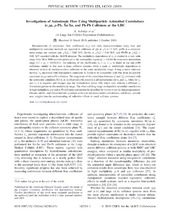Investigations of anisotropic flow using multiparticle azimuthal correlations in pp, p−Pb, Xe-Xe, and Pb-Pb collisions at the LHC
Acharya, Shreyasi; Adamová, Dagmar; Adhya, Souvik Priyam; Adler, Clemens; Adolfsson, Jonatan; Aggarwal, Madan M.; Aglieri Rinella, Gianluca; Agnello, Michelangelo; Agrawal, Nikita; Ahammed, Zubayer; Alme, Johan; Altenkaemper, Lucas; Djuvsland, Øystein; Ersdal, Magnus Rentsch; Fionda, Fiorella Maria Celeste; Grøttvik, Ola Slettevoll; Nystrand, Joakim; Rehman, Attiq ur; Røhrich, Dieter; Tambave, Ganesh Jagannath; Ullaland, Kjetil; Wagner, Boris; Yang, Shiming; Yuan, Shiming; Zhou, Zhuo; Arsene, Ionut Cristian; Bätzing, Paul Christoph; Dordic, Olja; Lardeux, Antoine Xavier; Lindal, Svein; Mahmood, Sohail Musa; Malik, Qasim Waheed; Richter, Matthias; Røed, Ketil; Skaali, Toralf Bernhard; Tveter, Trine Spedstad; Wikne, Jon Christopher; Zhao, Chengxin; Helstrup, Håvard; Hetland, Kristin Fanebust; Kileng, Bjarte; Nesbø, Simon Voigt; Storetvedt, Maksim Melnik; Langøy, Rune; Lien, Jørgen André; Ahmad, Shafiq F.; Ahn, Sang Un; Aiola, Salvatore; Akindinov, Alexander; Al-Turany, Mohammed; ALICE, Collaboration
Peer reviewed, Journal article
Published version

Åpne
Permanent lenke
https://hdl.handle.net/1956/23737Utgivelsesdato
2019Metadata
Vis full innførselSamlinger
Originalversjon
https://doi.org/10.1103/physrevlett.123.142301Sammendrag
Measurements of anisotropic flow coefficients ( v n ) and their cross-correlations using two- and multiparticle cumulant methods are reported in collisions of p p at √ s = 13 TeV , p − Pb at a center-of-mass energy per nucleon pair √ s NN = 5.02 TeV , Xe-Xe at √ s NN = 5.44 TeV , and Pb-Pb at √ s NN = 5.02 TeV recorded with the ALICE detector. The multiplicity dependence of v n is studied in a very wide range from 20 to 3000 particles produced in the midrapidity region | η | < 0.8 for the transverse momentum range 0.2 < p T < 3.0 GeV / c . An ordering of the coefficients v 2 > v 3 > v 4 is found in p p and p − Pb collisions, similar to that seen in large collision systems, while a weak v 2 multiplicity dependence is observed relative to nucleus-nucleus collisions in the same multiplicity range. Using a novel subevent method, v 2 measured with four-particle cumulants is found to be compatible with that from six-particle cumulants in p p and p − Pb collisions. The magnitude of the correlation between v 2 n and v 2 m , evaluated with the symmetric cumulants SC ( m , n ) is observed to be positive at all multiplicities for v 2 and v 4 , while for v 2 and v 3 it is negative and changes sign for multiplicities below 100, which may indicate a different v n fluctuation pattern in this multiplicity range. The observed long-range multiparticle azimuthal correlations in high multiplicity p p and p − Pb collisions can neither be described by pythia 8 nor by impact-parameter-Glasma, music, and ultrarelativistic quantum molecular dynamics model calculations, and hence, provide new insights into the understanding of collective effects in small collision systems.
